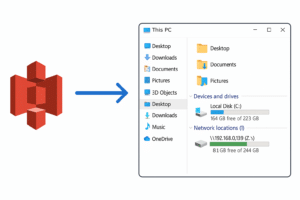S3-Speicher als zugeordnetes Laufwerk: Warum es für Unternehmen wichtig ist
Amazon Simple Storage Service (S3)S3, 2006 von AWS eingeführt, ist ein skalierbarer Objektspeicherdienst für eine Vielzahl von Anwendungsfällen, darunter Anwendungsdatenspeicherung, Backups, Disaster Recovery, Datenarchivierung, Analytics-Data-Lakes und Hybrid-Cloud-Umgebungen. S3 basiert auf derselben Infrastruktur wie die E-Commerce-Plattform von Amazon.com und bietet zuverlässigen, webbasierten Zugriff zum Speichern und Abrufen aller Datentypen. S3 Storage als zugeordnetes Laufwerk entspricht jedoch nicht seiner ursprünglichen Aufgabe. Lesen Sie weiter, um mehr darüber zu erfahren, wie auf S3 als zugeordnetes Laufwerk zugegriffen werden kann.

S3- und S3-kompatible Speicherdienste haben sich zur bevorzugten Wahl für skalierbare und kostengünstige Dateispeicherung in der Cloud entwickelt. Obwohl Objektspeicher im Hintergrund hervorragend funktionieren, sind sie nicht immer benutzerfreundlich – insbesondere für Teams, die mit zugeordneten Netzwerklaufwerken oder herkömmlichen Dateiservern arbeiten.
Hier kommt die Idee ins Spiel, ein Laufwerk dem S3-Speicher zuzuordnen. Dadurch erhalten Benutzer die gewohnte Erfahrung der Arbeit mit Dateien über einen Laufwerksbuchstaben oder den Datei-Explorer, während IT-Teams von den Vorteilen des Cloud-basierten Speichers profitieren.
Es gibt einige Gründe, warum Unternehmen S3-Speicher als zugeordnetes Laufwerk verfügbar machen möchten:
-
Einfacher Zugang – Endbenutzer müssen sich nicht in ein neues System einarbeiten. Sie erhalten ein zugeordnetes Laufwerk, das sie wie jede andere Netzwerkfreigabe durchsuchen können.
-
Zentralisierter Speicher – Dateien können in der Cloud gespeichert werden und sind von überall aus zugänglich – kein VPN oder Synchronisierungstools erforderlich.
-
Flexibilität des Anbieters – Sie sind nicht an AWS gebunden. Dutzende Anbieter unterstützen die S3-API, oft zu geringeren Kosten oder mit auf unterschiedliche Anwendungsfälle zugeschnittenen Funktionen.
-
Reduzierte Infrastruktur – Durch die Verwendung von S3 werden lokale Dateiserver überflüssig, was die Wartung und Sicherungsstrategien vereinfacht.
Zu den Anbietern, die die S3-API unterstützen, gehören unter anderem:
-
Amazon S3
-
Backblaze B2
-
Cloudflare R2
-
DigitalOcean Spaces
-
IBM Cloud Object Storage
-
IDrive e2
-
Linode
-
MinIO
-
Oort DSS
-
Oracle Cloud-Speicher
-
Skalierbarkeit
-
Seagate Lyve Cloud
-
Wasabi
-
Jeder benutzerdefinierte S3-kompatible Dienst
Auch wenn das Konzept einfach klingt, handelt es sich bei S3 nicht um ein Dateisystem, sondern um einen Objektspeicher. Das bringt einige echte Herausforderungen mit sich, wenn man versucht, es als Laufwerk darzustellen.
-
Keine echten Ordner – Was wie ein Verzeichnis aussieht, ist in Wirklichkeit nur ein Pfad im Objektnamen.
-
Keine native Dateisperre – Zwei Benutzer, die dieselbe Datei bearbeiten, können sich leicht gegenseitig überschreiben.
-
Latenz – S3 ist für die Übertragung großer Dateien konzipiert, nicht für den schnellen Zugriff im Dateisystemstil.
-
Berechtigungen und Identität – Die Verwaltung des sicheren Zugriffs bedeutet normalerweise den Umgang mit IAM-Richtlinien, vorsignierten URLs oder externen Identitätssystemen.
Aus diesem Grund erfordert die Laufwerkszuordnung normalerweise Middleware oder Tools von Drittanbietern, die zwischen dem Benutzer und S3 sitzen und Dinge wie Dateisystememulation, Caching und Zugriffskontrolle handhaben.
Trotz der Komplexität kann die Bereitstellung von S3-Objektspeicher als zugeordnetes Laufwerk eine praktische Lösung sein – insbesondere für Hybridumgebungen, Remote-Arbeitsszenarien oder Organisationen, die ihre lokale Infrastruktur reduzieren möchten.
Der Schlüssel liegt darin, das richtige Tool zu finden, um die Übertragung zwischen Objektspeicher und Benutzererwartungen zu bewältigen. Das bedeutet, dass Dateisystemverhalten, Zugriffskontrollen, Latenz und Kompatibilität verwaltet werden müssen – all dies kann mit Standardtools allein nur schwer zu bewältigen sein.
Hier kann MyWorkDrive helfen. Durch die Bereitstellung einer sicheren, Cloud-fähigen Plattform, die den Zugriff auf zugeordnete Laufwerke auf jeden S3-kompatiblen Speicher ermöglicht, behebt MyWorkDrive viele der Einschränkungen von Objektspeichern und gewährleistet gleichzeitig die Benutzerfreundlichkeit. Es bietet Dateisperren, Berechtigungskontrollen und optimierten Zugriff.alles ohne VPN oder Datensynchronisierung.
Für Unternehmen, die die Vorteile von S3-kompatiblem Speicher nutzen möchten, ohne die Arbeitsweise der Benutzer zu beeinträchtigen, lohnt es sich zu prüfen, wie sich eine solche Lösung in ihre umfassendere IT-Infrastruktur einfügen lässt.
